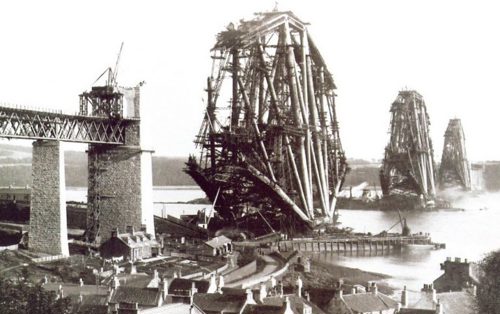West footpath/cycleway is currently closed for essential maintenance, please use the east footpath/cycleway.
Access Restrictions
History of the Forth Bridge
Ancient Crossing
Forth Bridge HistoryA regular ferry operated between North and South Queensferry as far back as the 12th century. It was established for those making the pilgrimage to St Andrews.
By the 18th century, it was reckoned to be the busiest ferry in Scotland, linking the North East of the country with Edinburgh and the south.

A Bridge for the Railway Network
A regular ferry operated between North and South Queensferry as far back as the 12th century. By the 18th century it was reckoned to be the busiest ferry in Scotland, linking the north east of the country with Edinburgh and the south.
The coming of the 19th century brought a major improvement in the form of ramped piers on either side of the Forth, which could be used by sailing ships at any stage of the tide. These piers, built between 1808 and 1817, were used by ferries right up until 1964, when the Forth Road Bridge opened.
There were plans for an alternative crossing which was not weather dependent, with a 1806 proposal for a tunnel under the Forth and a design for a suspension bridge submitted in 1818.

It was the spreading of the railway network in the middle years of the century, however, that underlined the need for a bridge.
A young engineer called Thomas Bouch arrived in 1849, determined to solve the problem of the Forth and Tay estuaries.
He first devised a system where trains were floated over the water on platforms, which impressed the directors of the North British Railway enough to listen to his ideas for bridges across the two estuaries.
The Tay Bridge was begun in 1871 and the foundation stone laid for a suspension bridge across the Forth in 1873. However, this project came to an abrupt end when, three days after Christmas 1879, the Tay Bridge collapsed in a storm, with the loss of an estimated 75 train passengers.
The tragedy meant an end to Bouch’s bridge plans – in fact he died the following year – but the momentum for a crossing had grown and a new design, by John Fowler and Benjamin Baker, was submitted to the Forth Bridge Company in May 1881, with construction authorised by Parliament in July 1882.
The following year, in 1883, work began on the Forth Bridge we know today, an iconic marvel of design and engineering skills known the world over.








